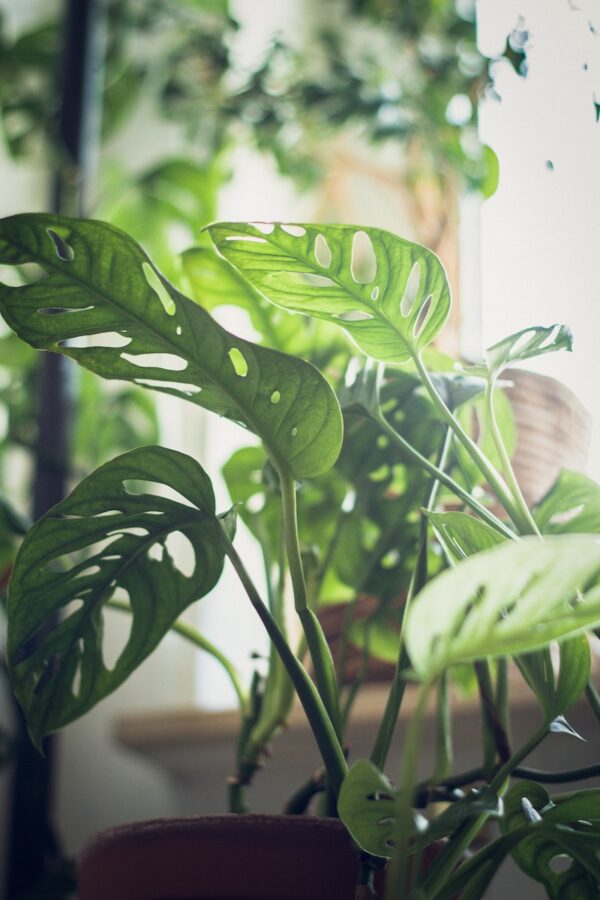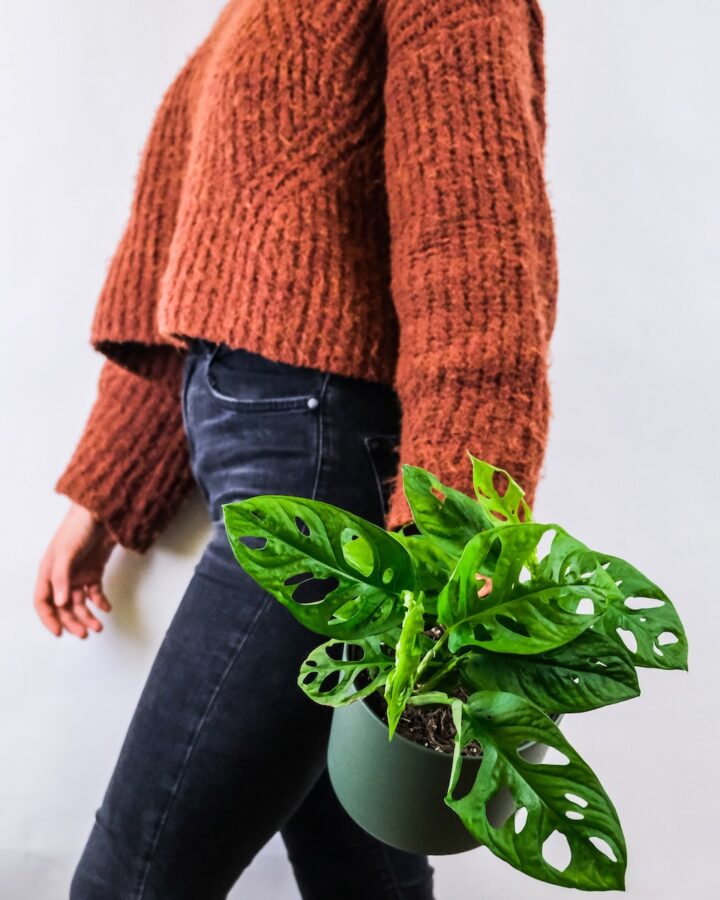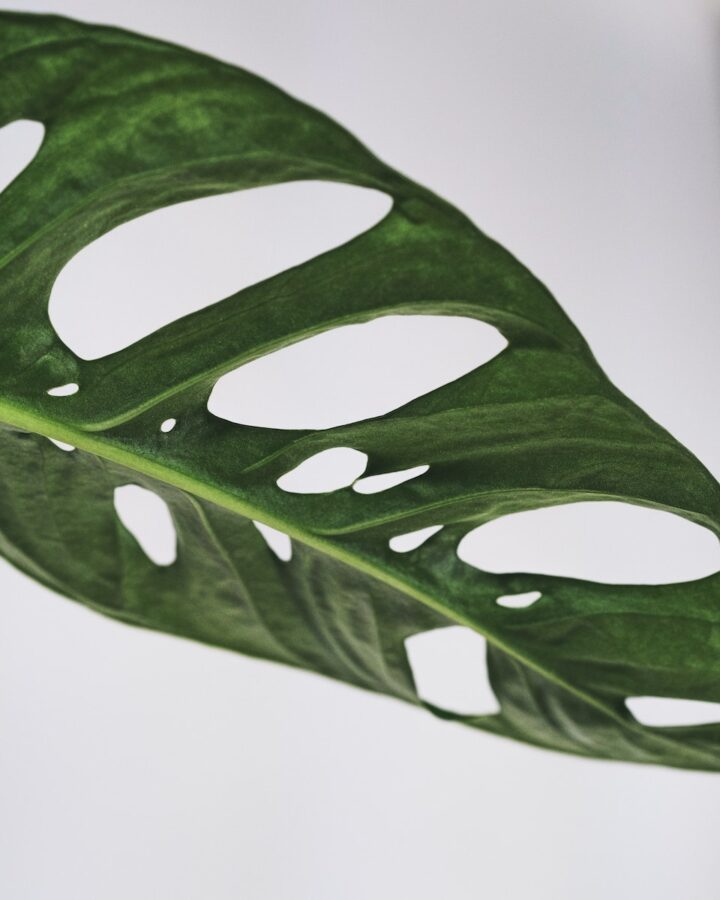Monstera adansonii, sometimes also known as Monstera friedrichsthalii, is a species of flowering plant in the family Araceae, which is vastly distributed across much of Central and South America. The plant is also fairly widespread in various islands in the West Indies, including Antigua, Trinidad, Tobago, Grenada, St. Kitts, Dominica, Martinique, Guadeloupe, St Vincent, and St. Lucia. In countries where the plant grows natively, it’s commonly found near river valleys.
Monstera adansonii goes by numerous common names, including the Swiss cheese plant, Adanson’s monstera, monkey mask plant, trailing split–leaf, and the five holes plant. These names are inspired by the plant’s pointy, heart-shaped leaves which feature dramatic hole formations, nearly similar to those of Swiss cheese.
Adanson’s monstera is an ornamental, evergreen plant that’s best suited for indoor growing. The plant is reasonably easy to grow and requires minimal to moderate care. All you need to do is establish an ideal growing environment and be gentle with its perforated, delicate leaves.
This guide will offer you insights into the perfect growing conditions for Monstera adansonii.
Table of Contents
Monstera Adansonii Fun Facts

a) Size
Monstera adansonii are climbing plants. The plants can climb or trail to a length between 10 and 15 feet.
If subjected to ideal growing conditions, the Swiss cheese plant can comfortably achieve a height or length of 50 inches.
b) Leaves
Monstera adansonii leaves begin small but get incredibly big as the plants age.
The leaves are noted for their heart shapes and oval-shaped holes.
c) Growth Rate
The Swiss cheese plant is a relatively fast grower.
d) Plant Type
Monstera adansonii is a perennial plant. Perennials are plants that typically live longer than three years.
Adanson’s monstera grow and bloom over the spring and summer, during which they produce white flower blossoms. They then die back over the autumn and winter before returning in spring.
However, the Swiss cheese plant generally doesn’t bloom indoors.
How to Grow and Care for Monstera Adansonii

1. Choosing Between Seeds and Seedlings
Like most indoor plants, it’s easier to grow Monstera adansonii from seedlings than seeds. In fact, it’s best to look for established starter plants.
But if you decide to grow your monkey mask plant from seeds, proceed as follows:
i. Fill a shallow tray with moistened soil.
ii. Bury the seeds in the tray.
iii. Cover the tray using plastic wrap.
This helps to trap moisture while also increasing the germination rate.
iv. Place the tray in a warm spot that’s exposed to bright, filtered light.
v. Mist the growing medium frequently to keep it moist.
Expect the seeds to germinate in a couple of weeks.
vi. After germination, you can remove the plastic wrap as you continue misting the growing medium.
vii. Wait for a few months before transplanting the seedlings.
2. Soil Requirements
Monstera adansonii is best suited for well-drained soils. You can achieve excellent soil drainage by using equal portions of sand, peat moss, and regular soil.
As you’re growing the plant indoors, be sure to poke holes underneath as well as on the sides of the container. This promotes drainage and aeration.
It’s also important to provide the plant with an arch or trellis to support its trailing vines.
3. Fertilization

Monstera adansonii is a relatively hardy plant that can thrive without intensive fertilization. In most cases, all you’ll need to do is get the right soil composition.
However, note that the Swiss cheese plant grows remarkably fast. Without fertilizer, the plant wouldn’t be able to synthesize enough chlorophyll. That could result in the yellowing of the leaves.
So, it’s important to fertilize the five holes plant from time to time. Applying a small amount of all-purpose liquid fertilizer once a month would do.
It’s also important to avoid fertilizing Swiss cheese plants between four and six weeks of potting or repotting them. That’s because the potting mix usually contains a substantial amount of slow-releasing fertilizer in it.
4. pH Range
The Swiss cheese plant does well in acidic to neutral soils.
The ideal pH range is anywhere between 5.5 and 7 on the pH scale.
5. Watering
Watering is the most challenging part of Monstera adansonii care. That’s because these plants prefer their soil to be consistently moist but not overly soggy. The plants tend to dry out up to around 75% before they need watering again.
So, how do you come up with an effective watering routine?
First off, never allow your Swiss cheese plants to sit in waterlogged soils. That can escalate root rot.
Also, keep the soil moist at all times. This is especially important during warmer weather.
Lastly, the amount of water you give to your Monstera adansonii plants may also depend on the pot size and soil type. Well-drained soils (which are the ideal soils for growing these plants) would require more frequent watering than poorly-drained soils. The same is true for larger growing pots.
6. Light Requirements

Monstera adansonii prefers bright, filtered light. The plant may also survive in conditions with lower, indirect light. That explains why they do quite well on the forest floor, under the cover of dense foliage.
For optimized growth, keep your Swiss cheese plants in a bright spot but in an area free from direct sunlight. An ideal place would be near, but not in, an east-facing window.
If you must expose Monstera adansonii to direct light, limit the exposure to 2 – 3 hours.
7. Temperature Conditions
Monstera adansonii thrives in warm temperatures, typically between 60 and 80 degrees centigrade.
Ensure that temperature conditions in your house don’t fall below 40 degrees for long. Otherwise, the plants may start to die off.
Also, avoid placing your Swiss cheese plants near cold drafts and direct airflow from air conditioning or heating vents, especially during the winter months.
8. Humidity
As it’s a tropical plant, the Adanson’s monstera will do well in an average household humidity, usually levels above 50%.
But if you live in regions that experience dramatic fluctuations in humidity, you might want to invest in a humidifier before bringing this plant into your house. Alternatively, keep the plants near warm, bright bathrooms.
Other common ways to boost humidity include misting the plants and using a pebble tray.
Most importantly, always look out for signs of low humidity, such as browning on the leaves, and adjust accordingly.
9. Pest and Disease Control
Monstera adansonii is susceptible to most pests that trouble common houseplants. Examples include spider mites, mealybugs, and scale.
The good news is that these pests will stop bothering your plants and retreat to their natural habitats after feeding. So, they’re unlikely to become problematic.
That said, it’s important to inspect your Swiss cheese plants occasionally for signs of infestation. When checking for pests, pay particular attention to the parts of the plant where the leaves hit the stems, as well as underneath the leaves. Pick off any pests you come across during these routine checks. In the event your monkey mask plants have attracted a significant number of pests, you can control the bugs using safe insecticides.
In terms of disease, the trailing split-leaf is likely to be plagued by root rot, powdery mildew, blight, and rust. However, incidences of disease are generally lower if the plants are raised under ideal growing conditions.
The best way to tell that your Monstera adansonii plants are diseased is by checking their leaves. Yellowing of the leaves indicates disease as well as overwatering, whereas blackening of the leaves is a sign of exposure to direct sunlight.
10. Pruning
Pruning Monstera adansonii serves two crucial purposes.
First, it helps to clear the plant of dead or unhealthy growth.
Pruning is also important when you’re seeking to train or propagate your Swiss cheese plants.
Potting and Repotting

Swiss cheese plants will be fine growing in any container with enough drainage holes. In the interest of aesthetics, you might consider hanging baskets.
When potting Monstera adansonii, it’s best to go for a spacious container. This allows the roots to spread out freely.
Also, remember to repot every two years. The best time for potting and repotting is around spring when the weather is more favorable.
Propagation
The Swiss cheese plant is incredibly easy to propagate.
Here’s how to go about propagating the plant:
i. Trim off 4 – 6 inches from a stem, cutting right after a leaf node.
ii. Remove leaves located between the bottom-third and half of the cuttings.
iii. Place the cuttings in a glass of water.
Nodes will start to emerge in a couple of weeks. Those are aerial roots.
iv. Transfer the plant to a container and care for it for a few weeks before eventually transplanting it to the garden.
Wrap Up

If you’ve been toying with the idea of growing a Monstera adansonii but didn’t know where to start, we hope you’re enlightened after reading this post.
As a parting shot, remember that the Swiss cheese plant is mildly toxic to pets. So, be sure to keep the plant in a spot where your furry friends cannot nibble the leaves.

